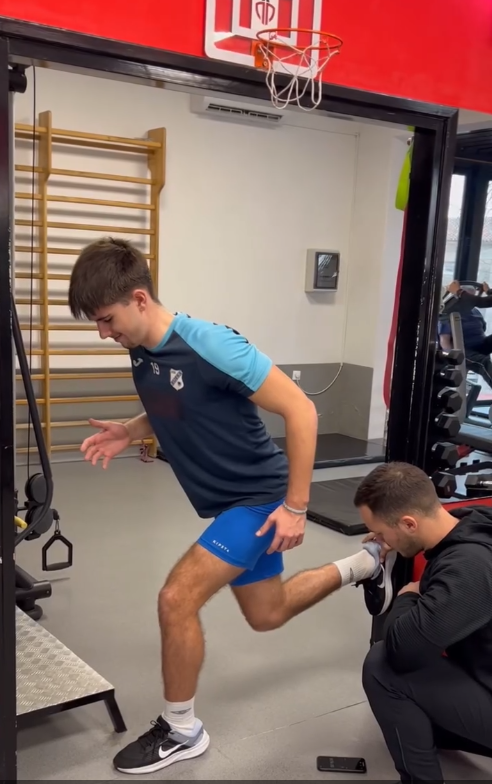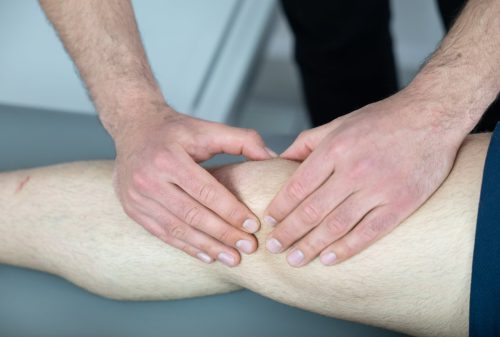Shin splints is a colloquial term that, for many years, encompassed any pain in the front and often the back of the lower leg, particularly when caused by intense training. However, the lower leg and foot are complex biomechanical systems and, as such, do not tolerate generalizations. They require precise diagnosis, followed by appropriate and targeted treatment.
Shin splints
Description
In a narrower sense, runner’s shin refers to a condition professionally termed medial tibial stress syndrome or MTSS. It describes pain and a pathological process in the inner side of the lower third of the tibia. The pain occurs during or after physical activity involving running and/or jumping, and it may also appear during walking. Tenderness is localized along the very edge of the bone, particularly in the soft tissues adjacent to it. Most commonly, the inflammation affects the attachment of the tibialis posterior muscle, although the flexor digitorum longus and flexor hallucis longus may also be involved, albeit rarely.
While it sounds complicated (and it is not simple), any soccer player who has ever experienced problems with their shinbone lining will instantly point to the exact spot where this painful syndrome manifests. Supporting this, statistics show that one in five athletes sidelined from their sport owes it to runner’s shin. This is particularly relevant for sports involving running and jumping, such as soccer, track and field, handball, and even martial arts.
 As with other overuse syndromes, runner’s shin results from cumulative forces acting on the muscle attachment to the bone, pulling it long and hard enough to cause microdamage. The accumulation of these microinjuries eventually exceeds the body’s recovery capacity, leading to inflammation and accompanying pain. This often disrupts normal training and, in some cases, even walking.
As with other overuse syndromes, runner’s shin results from cumulative forces acting on the muscle attachment to the bone, pulling it long and hard enough to cause microdamage. The accumulation of these microinjuries eventually exceeds the body’s recovery capacity, leading to inflammation and accompanying pain. This often disrupts normal training and, in some cases, even walking.
There are many faces to runner’s shin. Pain may occur at the start of a training session, disappear after warming up, and reappear at the session’s end. It can also be felt only during intense activities like running uphill or jumping, but it is often present even during walking, exacerbated by physical activity. It commonly arises during the early stages of athletic conditioning when running and jumping activities intensify suddenly. At Scipion, we see more cases of runner’s shin in summer and early autumn than at other times of the year.
Accurate diagnosis is crucial and requires a specialist physical examination. By simply pressing on the painful area and performing stretching tests, other soft tissue injuries in the vicinity can be ruled out. The extent of inflammation can be determined using ultrasound imaging. If a stress fracture (bone break caused by excessive muscle pull) is suspected, an X-ray, scintigraphy, or MRI is recommended. Once a diagnosis is made, proper therapy begins.
Under the broader term of runner’s shin, pain located at the front and upper part of the lower leg, a few centimeters below the knee, can also be included. This condition arises under the same circumstances as the “true” syndrome but structurally differs. Here, microtrauma accumulates directly within the muscles: tibialis anterior, peroneus longus, and peroneus brevis. Treatment is usually simple and quick, involving ice packs, massage, and adequate stretching exercises. Rarely, in cases of completely neglected injuries, treatment may last longer than a few weeks. In this scenario, it is crucial to rule out compartment syndrome, a severe condition that can lead to significant consequences—but that is an entirely different story.
In the narrower sense, runner’s shin, or medial tibial stress syndrome (MTSS), is an inflammatory process on the inner side of the lower third of the tibia, caused by overuse at the muscle-to-bone attachment. Several forms of this inflammation exist. The first is acute, where pain is intense and prevents normal walking. It may progress to a subacute state, where pain is less intense but worsens with physical activity. Poor treatment, ignoring the pain, or other circumstances can lead to chronic inflammation, which is exceptionally challenging to treat. Recovery from the onset of symptoms to full return to activity can range from weeks to over a year, depending on the injury’s type and severity.
It is worth noting a condition known as transient painful shin, which mimics all symptoms of inflammation but resolves spontaneously after a few days of rest. This state often delays athletes from seeking diagnostics and treatment. Waiting for spontaneous healing, many injured athletes continue training at the same or slightly reduced intensity, further exacerbating the pathological process and tissue damage.
Upon diagnosis, it is necessary to reduce or cease physical activity. For acute conditions, a full range of anti-inflammatory treatments is essential, including ice packs, elastic bandages, lymphatic drainage, and, if necessary, analgesics and anti-inflammatory drugs. After a few days of this treatment, physiotherapy commences, utilizing modalities such as electrotherapy, ultrasound, laser therapy, radiofrequency therapy, and magnetotherapy to promote and accelerate healing. This phase also involves kinesitherapy, or tailored exercises, which are effective only when customized to address imbalances in muscle strength and flexibility, identified through detailed diagnostics. Stretching, strength, and balance exercises are generally beneficial during this stage.
A critical phase of therapy is the return to training after symptom reduction. This must be gradual, adhering to all preventive measures. Chronic cases, where symptoms persist for months, require a different approach, including techniques like cross-friction massage to accelerate tendon tissue recovery. Shockwave therapy can also be helpful but must be combined with appropriate exercises and functional rehabilitation.
Athletes with flat feet are at higher risk of developing this syndrome. Using proper orthopedic insoles is both a preventive measure and part of treatment. Taping, or bandaging, can aid in returning to full activity. Proper sports footwear is essential, and studies indicate that worn-out shoes pose a significant risk for developing runner’s shin. When resuming training, it is crucial to check and correct running and jumping techniques to minimize stress on the musculoskeletal system. Above all, respecting training principles, dedicating time to warming up and stretching, and gradually increasing physical demands are vital to avoiding injury. Collaboration with coaches in preventing and treating this injury can reduce its frequency and shorten recovery time for affected athletes.
The tension model (click for article) provides a broader perspective on the syndrome’s causes, highlighting the role of the tibialis posterior muscle in maintaining foot balance during walking and running. Any dysfunction in the lower extremity’s kinetic chain disrupts force distribution, increasing strain on specific structures. Issues such as reduced hip mobility, knee pain, previous ankle sprains, poor running technique, lumbar spine problems, and weak abdominal muscles can all contribute to chronic runner’s shin. Comprehensive diagnostics, including tests like isokinetic assessment, balance measurement, and postural analysis, are essential for directing effective interventions, significantly shortening recovery time.







